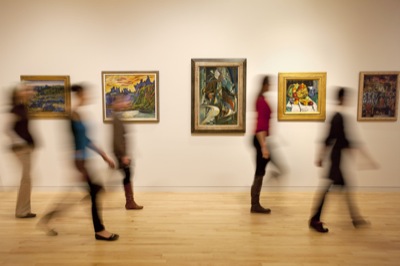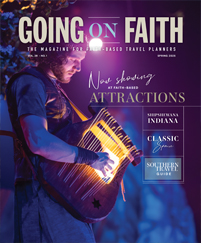
It’s time for a side of the South you’ve probably never seen.
There are many ageless elements of the Southeast, but that doesn’t mean this region is standing still. Big things are happening in large cities and smaller towns alike, bringing numerous sights to see that didn’t exist last time you toured the area. Several Southern museums have undergone extensive expansion projects, adding new components and exhibits to further enhance the visitor experience. In other areas, brand-new facilities are opening to give travelers a look at aspects of the South that they’ve never seen before.
Groups on tour in 2011 and beyond will find a fascinating look at the legacy of Hurricane Katrina in New Orleans, a reimagined celebration of the Kentucky Derby in Louisville and a new presentation of timeless craft and culture in rural Virginia. New museum expansions in Charlotte, North Carolina; Little Rock, Arkansas; and Athens, Georgia, round out our collection of what’s new in the South.
Kentucky Derby Museum
[ Louisville, Kentucky ]
Torrential rains hit Louisville in 2009, causing floods that did extensive damage to the Kentucky Derby Museum at Churchill Downs. The disaster forced the temporary closure of the museum, and the staff decided to make the most of the event and completely reimagine large portions of the museum experience.
“We decided it was a great opportunity to live up to our new mission, to share the fun of the Kentucky Derby experience,” said director of communications Wendy Treinen. “We gutted the first and second floors of the museum and created new concepts that are presented with new technology. It was a $5.5 million project.”
Curators spent months interviewing fans on the infield, race announcers, track employees and others associated with the event to create a more complete picture of the Derby. One new exhibit focuses specifically on race callers, introducing visitors to the skills involved in announcing a horserace, and then giving them a chance to call a race themselves using footage from past races.
Another exhibit uses touch-screen technology to present the stories of various people working and playing at the track one hour before the big race.
Georgia Museum of Art
[ Athens, Georgia ]
With a brand new wing that just opened in January, the Georgia Museum of Art at the University of Georgia nearly tripled its gallery space, allowing curators to display much more of the institution’s impressive permanent collection.
“The new expansion added 13 galleries dedicated to our permanent collection,” said chief curator Paul Manoguerra. “It’s the first time in a while that our permanent collection will be on permanent display. It’s a collection that belongs to the people of Georgia.”
The collection began as a gift of 100 American paintings given to the University of Georgia by a wealthy collector and has grown into a multifaceted array of artwork. The new galleries encompass 16,000 square feet of exhibit space that present the museum collection in various stages of art history. Two galleries focus on European art, including Italian Renaissance paintings replete with religious imagery. Six galleries will trace the development of American styles, from Colonial art to modern installation pieces, and two special galleries will highlight the traditions of decorative art in Georgia.
www.georgiamuseum.org
Heifer Village
[ Little Rock, Arkansas ]
Heifer International isn’t new — the nonprofit organization has been providing livestock to impoverished communities worldwide since 1944 — but Heifer Village is a new component of its headquarters in Little Rock. The exhibition gives visitors a look at the communities Heifer serves and the differences its work makes for local residents.
“We sent our exhibit people out to take pictures of real structures in Honduras, Nepal, Kenya, Vietnam and a Navajo reservation in Arizona,” said Jim Rollings, director of Heifer Village. “They came back and did a mock-up that resembles those structures so that we could talk about the houses people live in, their health clinics and their marketplaces.”
The village features several life-size and interactive components, such as a re-created street market, a biogas kitchen and a one-room schoolhouse. A model farm shows how Heifer livestock donations are used by Vietnamese farmers. This summer, the organization is adding an outdoor demonstration garden to the exhibit. A fair-trade gift shop at the site has jewelry, crafts, coffee and other products from the countries in which Heifer works.
“Living with Hurricanes”
[ Louisiana State Museum ]
It’s been more than five years since Hurricane Katrina devastated New Orleans and other parts of Louisiana — long enough to develop some historical perspective on the event and its impact on local people. Last October, the Louisiana State Museum opened a new permanent exhibit called “Living With Hurricanes: Katrina and Beyond” at its flagship facility, the Presbytere, in New Orleans.
“The show is devoted not just to Hurricane Katrina but the whole idea of living with hurricanes,” said Arthur Smith, the museum’s marketing and public relations director. “There are some emotional moments to it because of the nature of what happened here. It’s a great place to learn about the history of hurricanes, the science of hurricanes and the human drama of hurricanes here in the South.”
Numerous artifacts from Katrina help set the scene for visitors. At the centerpiece of the exhibit is Fats Domino’s piano, which was rescued from under piles of muck and debris in his home. Other highlights are Mardi Gras costumes made from blue FEMA tarps and a Torah scroll found in a heavily damaged Jewish synagogue.
Heartwood
[ Abingdon, Virginia ]
Construction is still under way in Abingdon, Virginia, where Heartwood will open June 25. Organizers see this new cultural center as a way to engage visitors in the rich craft, music and heritage of the rural counties throughout southwest Virginia.
“Heartwood is an artisan center,” said Todd Christensen, executive director of the Southwest Virginia Cultural Heritage Commission. “We decided that instead of it being a retail outlet, it should be a gateway. We’re going to show exhibits, video and whatever else we can about the cultural assets of southwest Virginia, and we’re also going to have four large galleries of juried art from around the mountain.”
The center will include examples of fine art and traditional handcrafts representing the 19 counties in the region. But visitors will also find elements that spotlight other notable aspects of the state. A music room will feature information on the Virginia roots of country music and will include instruments made by the area’s master luthiers, and the center’s restaurant will serve a seasonal menu of locally produced organic foods.
Mint Museum Uptown
[ Charlotte, North Carolina ]
Since 2003, Charlotte residents have watched as the Levine Center for the Arts took shape in the city center. This four-acre cultural campus includes the Bechtler Museum of Modern Art and two theaters. The final component is the 145,000-square-foot Mint Museum Uptown, opened in October.
“At the Mint Museum Uptown, it’s a very modern building, and the art is more modern and contemporary,” said marketing and public relations manager Elizabeth Isenhour. “They did a great job giving us a space where we could really showcase the artwork. It has a really urban feel to it, and the flow through the galleries is really nice.”
The new facility complements the original Mint Museum location, now known as the Mint Museum Randolph. The Randolph facility now focuses on historic collections, and the Uptown location highlights contemporary American and European art and showcases modern craft and design in other galleries. Special touches include a rotating exhibition gallery, a family area designed to introduce children to artwork and a museum store that features crafts from North Carolina and South Carolina.










